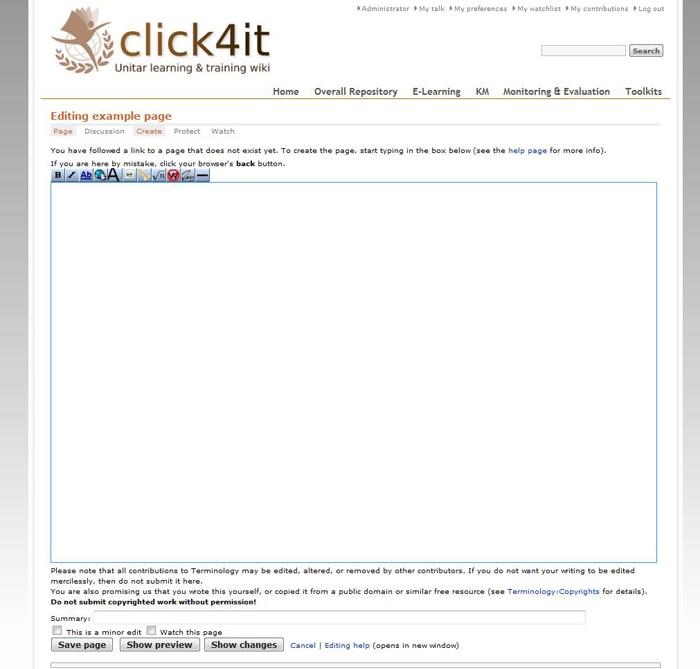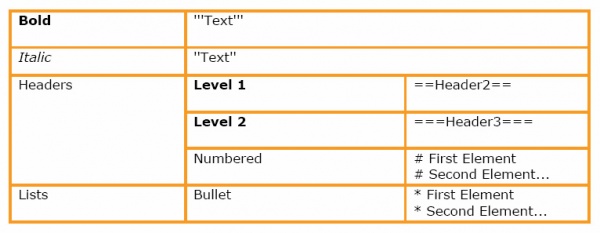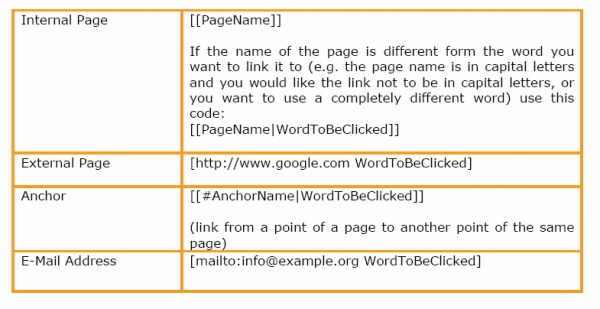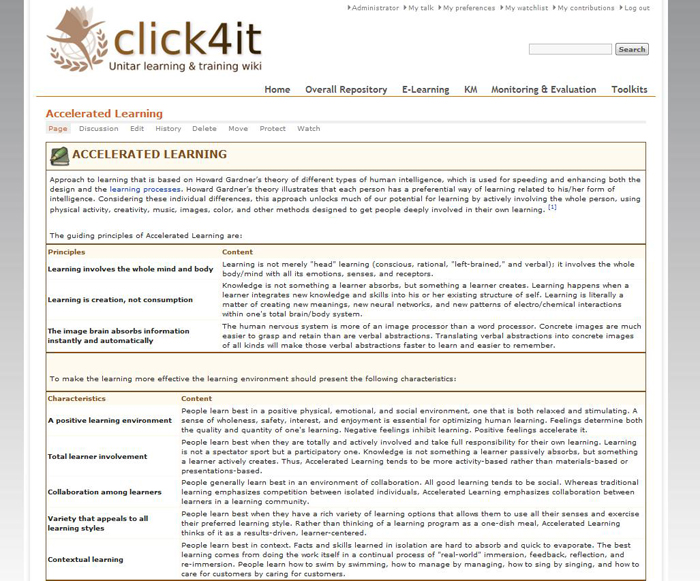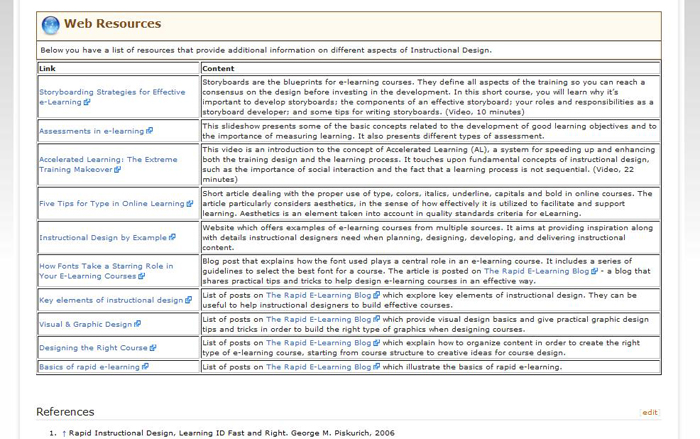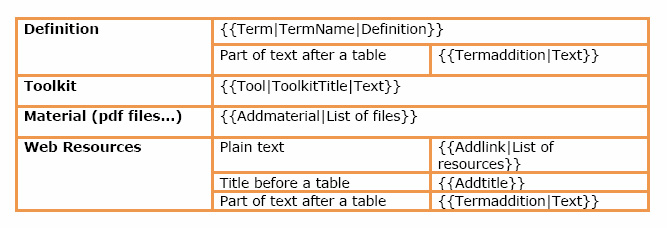click4it - Step by Step User Guide
This user guide should be sufficient for you to start working on the click4it website, maintaining the formatting style.
Should you require any additional information or clarification, do not hesitate to contact giulia.ortoleva@unitar.org
 This document is also available in pdf version. This document is also available in pdf version.
Introduction
What is a Wiki?
A wiki is a page or collection of Web pages designed to enable whoever is given the editing rights to contribute or modify content, using a simplified markup language. Wikis are often used to create collaborative websites and to power community websites.
One of the characteristics that make a wiki different from other websites is the fact that users having an account can add new pages to the site, change the content of the existing pages, upload pictures and files and create links to external and internal web pages.
These features make a wiki a perfect tool to build the click4it website - a dynamic collaborative environment where to collect and share information and materials on training methodologies.
With everyone contributing, it would be possible to transform the click4it website into a knowledge base platform for training tools and methods.
A notable difference between a wiki and a traditional website is that a wiki uses a simplified markup language. This particular syntax makes the editing much easier for people who are not familiar with the HTML language.
Increasingly, wikis are making "WYSIWYG" ("What You See Is What You Get") editing available to users. Using the icons from the WYSIWYG toolbar (e.g. bold, italic) the users can easily add/edit content.
The same editing tools available in the “WYSIWYG”, as well as other features, are associated with a particular syntax, easy to memorize. Thanks to this syntax, the users have a wide range of formatting possibilities that make a page much more interesting than plain text.
What is a template?
A template is an important feature that makes a wiki page user-friendly. A standard element saved in the wiki, the template can be used as a model for all the other pages of that wiki. The HTML syntax of this template is saved in the wiki and a name is associated to it. The user should only recall the name associated with the available templates to be able to easily use them.
The example below clarifies this point:
The definitions in the click4it wiki are written in a light blue box, with a small image of a book and a pen in the left corner. This box is a template. The HTML code associated with the box has been created once and saved in the template section. The name of the template is Term.
To write a definition inside this template, type - or copy and paste - the following code in the editing section of a new page:
{{Term|TERMNAME|Definition}}
The editing section of a new page looks like this:
"What You See Is What You Get" editor toolbar icons:
Use the following icons to:
- format selected text in bold
- format selected text in italics
- create a link to an internal click4it wiki page
- create an external link (remember to add the http:// prefix)
- format the selected text into a Level 2 Headline
- embed an image file
- embed a media file
- include mathematical characters
- override the existing formatting in this wiki
- add a signature with a timestamp
- add a horizontal line that separates two or more paragraphs in your entry
Once you have typed or coped and pasted the info into the template, the formatting will be similar to the following:
 TERMNAME TERMNAME | | Definition |
To modify an existing page, and/or to add new terms, toolkits and material, follow these step-by-step instructions.
Editing a page
To assure the quality of the material that will be published on the click4it site, editing rights will be granted only to registered users.
To make any modification within the site, the user should log in first.
- Registered users: If you already have an account, go to the upper right corner of any page and click on login/create an account. Once you enter your login and password, you will be able to make modifications to any page, to add new pages, links or documents.
- New users: If you don’t have an account yet, please request it to: giulia.ortoleva@unitar.org. You will receive an email with your username and password.
Modifying an existing page
- Go to the page you want to modify and select Edit. This tab is located on the top of the wiki page, right above the title.
- In the editing section, position the cursor on the point where you want to make corrections and/or modifications (add simple text, link to some other page of the wiki, etc.) and start typing.
- Please refer to the list of basic syntax needed to edit a page.
- Formatting text:
- Adding links:
- Uploading files or images:
- Adding tables:
- The basic way to add a table is to use the syntax below, adding as many columns as necessary. The number of columns depends on the number of headers set at the beginning. To create a new row, add a new section by typing |-
- {| class="wikitable"
- |-
- ! header 1
- ! header 2
- ! header 3
- |-
- | row 1, cell 1
- | row 1, cell 2
- | row 1, cell 3
- |-
- | row 2, cell 1
- | row 2, cell 2
- | row 2, cell 3
- |}
- Note: The template and the table are not compatible: it is not possible to use a table inside a template. It is necessary to close the template (using this: }} ) before editing a table. Another template can eventually be opened afterwards.
How to add a reference to the References list
If you have added new information to a definition and you want the source to appear in the list of references at the end of the page, in the form of a footnote, follow these steps:
- Identify the place in the text where you want the footnote to appear and position the cursor on that spot. (As you will notice later on, once you've saved the footnote, you will see the number linked to the list of sources at the end of the page, not the source itself, even if you have to type it here).
- Add: <ref>title of the book or website (date of consulting)</ref>
- If it is not already written, add: <references/> at the end of the page.
- In order to keep the style of the pages homogeneous, enter 4 rows between the definition and the References section and add a title for it using this syntax: ==References==.
- The sources should also be included in the Bibliography of the website, where you can find two lists, one for the books and articles and another one for the websites. Websites should be added on the top of the list, always including dates when they were consulted.
Adding new terms, toolkits, material
In order to have the wiki harmonized, the respective templates need to be used whenever materials or toolkits are added or a brand new definition is created.
Follow these instructions to be sure to use the right format, keeping the click4it consistent.
Adding a new term
To add a new definition, you will need to create a new page called as the term you want to include. The easiest way to create a new page in a wiki is to create a link to it from an existing page.
- Go to the Overall Repository page.
-
- Select edit and add a link ([[Page Name]]) respecting the alphabetical order. The link will appear red, to show that this page does not exist yet.
- When you click on the red link, the following page opens:
-
- Now you can start entering text in the WYSIWYG editing box. When you finish and click on Save page, your entry will appear on a wiki page. As explained in the Introduction, you can use the WYSYWIG toolbar to perform basic formatting.
- Use the template called term: {{Term|TERMNAME|Definition}}
 TERMNAME TERMNAME | | Definition |
- Write the term you want to add in capital letters in the space marked as TERMNAME and use the space called definition to enter your explanation. It can be either a sentence or a very long definition.
- Use the instructions given in section A (page 6) to edit the page, add links to websites or documents, add references and tables.
- Note that it is not possible to integrate a table inside a template. If you want to have a table in the definition, you will have to close the template by entering : }}) and then add the table.
- If you would like to add more information in the definition below the table, add the template Termaddition:{{Termaddition|Text}}.
- The result will be a simple box, with the blue lines framing it and no title. It will look like the template is following from the previous one.
-
- Below you can see an example of the use of table and of the Termaddition template:
-
- The template definition ends before the first table. The text between the first and the second table and the last sentence are contained in the template Termaddition.
- Once the new definition has been created, all the sources of the information contained in it should be cited in the References section at the end of the page. The instructions to do so are in section A (page 8).
- The sources should also be included in the Bibliography of the website, where you can find two lists, one for the books and articles and another one for the websites. Websites should be added to the top of the list, always including dates when they were consulted.
- Once you have created the term in the overall repository, a link to it should also be added in the other terminologies where the term might belong to. For example, if the new term is related to e-learning, a link to it should also appear in the E-learning list. The following categories are currently listed: E-learning, Knowledge Management, Monitoring & Evaluation.
Adding a Toolkit
If a definition already exists, or you have already created it, and you want to add more information on how a particular method can be used, or how to put in practice a particular technique, you can use the toolkits template. The information contained in this section is supposed to be Step-by-Step or General Guidelines format.
Below you have an example of a toolkit from the click4it website:
- Go to the page of the definition where you would like to add a toolkit and click on Edit.
- Enter four empty rows between the end of the definition and the References section.
- Use the template called Tool: {{Tool|ToolkitTitle|Text}}
-
 ToolkitTitle ToolkitTitle | | Text |
- Use the instructions given in section A (page 6) to edit the page, add links to websites or documents, add references and tables.
- If you want to add a table, you should close the template and open a new one afterwards, as explained under point 7 of the previous section (page 10).
- Add the link to this page in the Toolkit Section, so that the users may know that they will be able to find more detailed information for that term.
Including additional material
If you have files related to a term that could be useful for other users of the click4it website, you might want to add a section of additional materials.
Additional materials must be uploaded in a PDF format.
- Go to the page of the definition where you would like to include additional material and click on Edit.
- Enter four empty rows between the end of the definition or the toolkit (if it exists) and the References section.
- Use the template called Addmaterial: {{Addmaterial| List of files}}
-
 Additional Materials Additional Materials |  List of files List of files |
- Create links to the files that you should have uploaded beforehand, as explained in section A (page 6). The syntax to link a site is: [[Media:FileName.extention|WordToBeClicked]]
- In the same line where you create the link to each file, in front of the link, add a small PDF file icon by typing this: [[Image: pdf.png]] so that the user may know what kind of file he/she is downloading (as shown in the image above).
Adding a list of web resources
Whenever you come across interesting websites related to a term on the click4it site (information, tools, examples, etc.), you might want to create a section to display all of these links.
When creating this section, include a brief explanation of what kind of information/materials are available on the page, so that the user would have an indication of the sort of information/material he/she will find in the link.
As shown in the example below, a good way to organize the information for this section is to use a table format.
- Go to the page of the definition where you would like to add a list of web resources and click on edit.
- Enter four empty rows between the end of the definition, the toolkit or the additional material (if these sections exist) and the References section.
- Use the template called Addlink: {{Addlink|List of resources}}
-
 Web Resources Web Resources | | List of resources |
- Create the links to the websites. The syntax to create a link to a website is: [http://www.google.com WordToBeClicked]
- It is a good rule to repeat the website name this way: [http://www.google.it www.google.it], so that the user sees which is the site he/she will be directed to.
- If you want to present all the links in a table format, you can use a different template: Addtitle: {{Addtitle}} starting right after the blue title - Web Resources.
-
 Web Resources Web Resources |
- This way you will be able to add a table right after the title. If you want to add then a part of text inside the usual box, you can use the template Termaddition, as shown in section B.1, point 6 (page 7).
Template- Quick reference list
|
